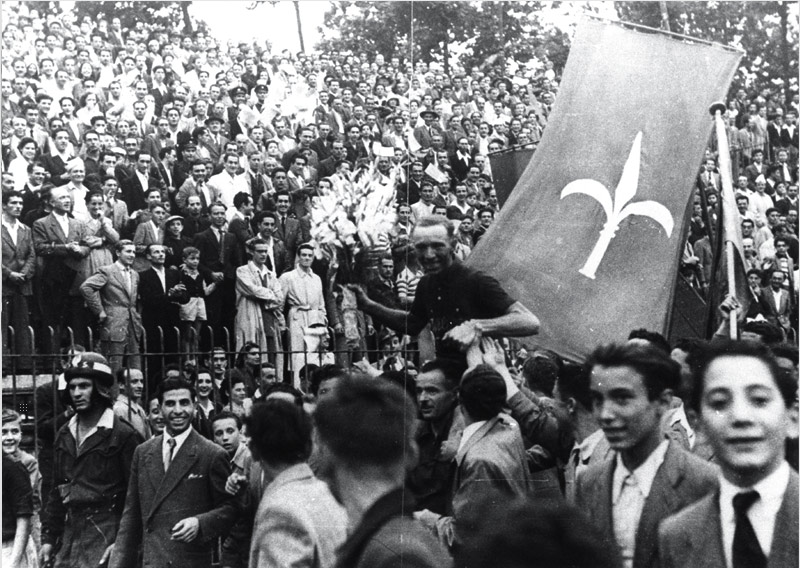It was the era of “bicycles”
Bassano del Grappa, summer 1906.
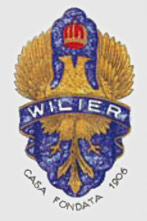 The mountains, over the horizon, were just a pleasant background. There was still no foreboding of the martial fury that just a few years later was to violate them and made them sacred for Italians. Even here in Bassano, on the banks of the Brenta, a certain air of Belle Époque was starting to be felt.
The mountains, over the horizon, were just a pleasant background. There was still no foreboding of the martial fury that just a few years later was to violate them and made them sacred for Italians. Even here in Bassano, on the banks of the Brenta, a certain air of Belle Époque was starting to be felt.
Technology showed miracles, promised revolutions, heightened minds, especially the most audacious and daring. Also bicycles had changed a lot. Compared to the French prototypes of fifty years prior, huge steps forward had been made in the concepts of steering, transmission, braking, using materials, comfort and appearance.
On their steel horses, now bicycles, wealthy young people from Bassano would strut in front of young ladies, showing off their balance on two wheels as feats of danger. At the beginning of the century, bicycles were not common yet and only a few could afford them. Foreign brands mostly and the stores which sold and repaired them were not always close to hand.
At Bassano the first bicycles appeared in the shop window of Saggiotto e Zaramella, where it was also possible to rent them.
A few years later, the bicycle became the most common means of locomotion for Italians, thanks to initiative of pioneers like the shopkeeper and craftsman Pietro Dal Molin from Bassano. He was fascinated by bicycles and the speed with which they were gaining popularity in daily life. While newspapers focused on the sporting achievements of the first moustached cyclists in England, France and Italy, Dal Molin decided to get involved in this adventure and play a part in it by opening a small workshop to manufacture bicycles. He purchased an almost unknown English brand, Wilier, and established his first modest workshop in San Fortunato, along the left bank of the river Brenta, which at that time was only crossed by a century old bridge, subsequently rebaptised by the popular saying “bridge of the Italian alpine troopers”. The Bridge of Victory, or new bridge, did not yet exist. The Wilier bicycle factory was founded here, a few feet from the river, below the tavern Alla Colomba where many people from Bassano spent their summer evenings playing bocce and enjoying the cool breeze from the Sugana Valley. Pietro Dal Molin was soon held in high regard for the high specification of his products. In Bassano owning a Wilier became fashionable, requests started coming in from far and wide and the modest workshop was expanded and enhanced. Mass production made possible with an industrial facility, kept the costs of the bicycles down and in turn encouraged their progressive distribution.
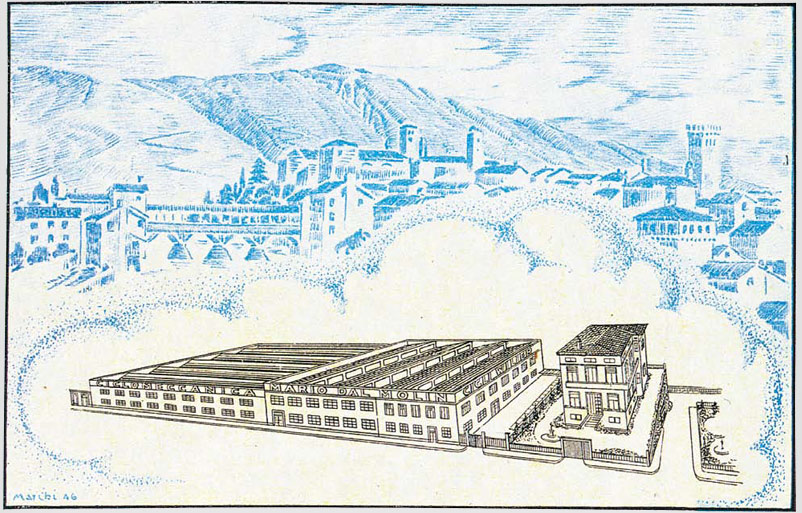 The establishment of Ciclomeccanica Dal Molin, owner of the brand Wilier, idealized in the background of Bassano del Grappa in a postcard dated 1946.
The establishment of Ciclomeccanica Dal Molin, owner of the brand Wilier, idealized in the background of Bassano del Grappa in a postcard dated 1946.At the time of the outbreak of the First World War, the Wilier company in Bassano was well established, with a constantly increasing production and excellent growth prospects. On all the peaks which crossed the northern horizon, from Pasubio to Grappa, battles waged and Bassano became a military crossroads a few kilometres from the frontline. The production of bicycles in the San Fortunato facility slowed down but did not stop. In a way the Dal Molin brand emerged reinvigorated by the conflict, especially thanks to the fame earned by the Italian rifle regiment, many members of which were equipped with Wilier bicycles. The end of the Great War coincided with the change in management of the company: Pietro Dal Molin, the founder of Wilier, gave the reigns of the company to his son Mario. His other son Angelo followed a parallel route by opening a bicycle and parts store in Bassano, in the central via Roma. As often happens when companies are passed on to children, several innovations were made, though still continuing along the path carved in the previous decade. The factory took the name of Ciclomeccanica Dal Molin and underwent a diversification process: in addition to manufacturing bicycles, new departments were opened, used for chrome and nickel plating. Years of prosperity followed. The bicycle became the most popular means of transport for Italians, while the achievements of Girardengo, Binda and Guerra sparked enthusiasm and desire in the people. In 1940, when Italy entered the Second World War as a belligerent force, Ciclomeccanica Dal Molin, which had received new military orders, had around a hundred employees.
In April 1945, when Italy was definitively in the hands of the allies, the Ciclomeccanica Dal Molin facility was seriously damaged by bombing. However, the end of the hostilities was close and the industry in Bassano was ready to start over and reconvert its production entirely to bicycles. All the processing phases would take place at its departments, from the welding of the steel pipes of the frames to painting and assembling all the components.

With Italy finally free from but exhausted by the war, cycling became legendary, particularly thanks to the astonishing reports that newspapers and the radio would spread about the mythical duels between Bartali and Coppi. At the same time sponsorship was becoming a common practice, alongside or even in place of the traditional names of locations or classical names. Legnano, Atala and Bianchi had already taken this approach and immediately after the War Mario Dal Molin decided to do the same. The most critical step was to start a collaboration with the illustrious Veloce Club Bassano, a company established in 1892 that boasted an extraordinary team of amateurs. Dal Molin had big plans. The idea of joining famous cyclists with credit developed in the winter of 1945 and coincided with the city of Trieste, bitterly contended by Tito’s partisan forces, longing for the Italian spirit, which sparked a wave of heated patriotism among Italians. A new team joined the professional cycling scene in 1946: it wore a red jersey and bore San Giusto’s halberd has its emblem. Practically a flag.
Ciclomeccanica Dal Molin devised a new sports bicycle and called it Wilier Triestina. The unmistakable copper reflection of its colour was immediately patented and would become the company’s distinguishing feature for decades. Dal Molin and his trusted advisors from the Veloce Club Bassano entirely supported Trieste’s cause. So no one other than the strongest cyclist from Trieste could become the symbol of this adventure: Giordano Cottur had already charmed sports enthusiasts from Bassano by winning the harshest uphill races (from Bassano to the top of Mount Grappa) for amateurs for two years running (in 1935 and 1936). The same race had been won by Gino Bartali in 1934. He became Wilier Triestina’s captain, with the compatriots De Santi, Feruglio and Degano and the Venetian Bevilacqua, Piccolroaz, Menon and Brotto at his side. The jersey was dedicated to Trieste while the shorts bore the original indication of the company: “Dal Molin – Bassano del Grappa”. The technical management of the newly established company was also entrusted to a local: Giovanni Zandonà, who in those years was also the mayor of the municipality of Loria, a town ten kilometres from Bassano del Grappa, and boasted a brilliant past as a professional cyclist, also as a member of the national team. In the meanwhile the Wilier name had become so entrenched with the nationalistic push raised by the Trieste issue that someone started to see a daring patriotic acronym in that exotic sounding name: W Italia Libera e Redenta (hooray for a free and redeemed Italy).
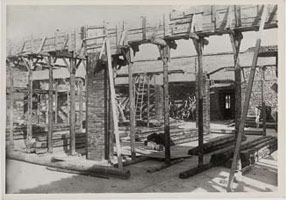 Reconstruction work in the building of the “Ciclomeccanica Dal Molin” after the bombing in 1945.
Reconstruction work in the building of the “Ciclomeccanica Dal Molin” after the bombing in 1945.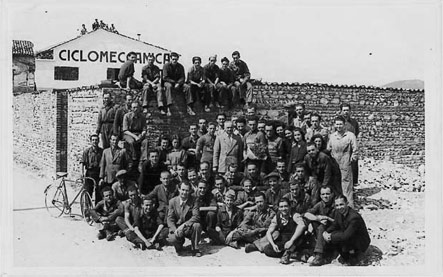 Mario Dal Molin surrounded by employees and the athletes of the newly formed red-halberd team.
Mario Dal Molin surrounded by employees and the athletes of the newly formed red-halberd team.
